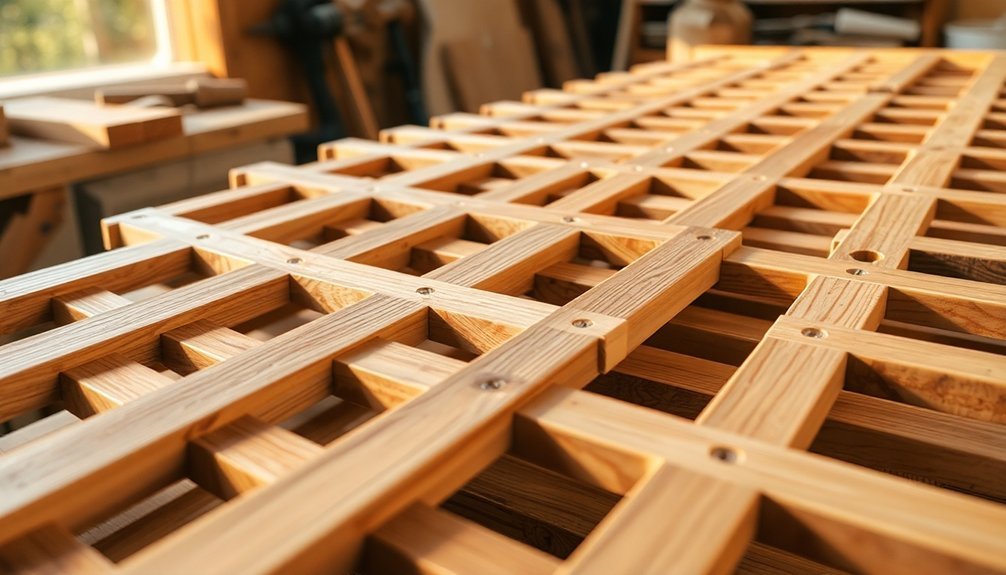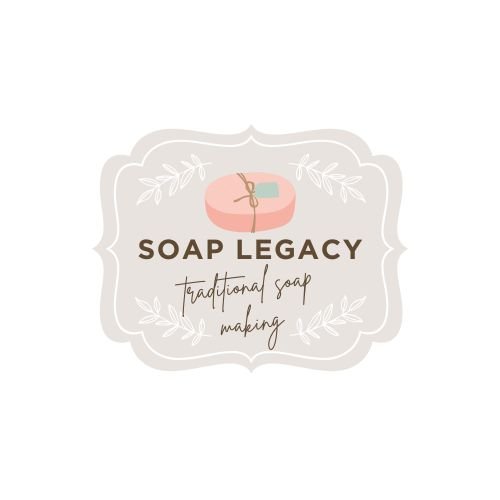Wooden drying racks are traditional tools used to cure handmade soap over 4-6 weeks. You'll find these racks made from untreated hardwoods like oak or maple, with slatted designs that maximize airflow around your soap bars. They naturally absorb excess moisture while preventing deformation during the vital hardening process. Proper spacing of 2-3 inches between bars guarantees even curing without mold growth. Discover why many artisans still choose these heritage methods over modern alternatives.
The Historical Significance of Wooden Drying Frames in Soap Making

Artisans throughout history have relied on wooden drying racks as the unsung heroes of quality soap production.
These wood frames, often crafted from durable hardwoods like oak and maple, represent centuries of traditional soap-making wisdom. You'll find that their porous nature serves an essential purpose—absorbing excess moisture while promoting essential airflow around your curing soaps.
When you place freshly cut bars on these racks, you're participating in a practice that dates back generations.
The natural properties of wood support the vital 4-6 week drying period, during which excess water evaporates and your soap bars harden properly. This traditional curing method guarantees you'll produce longer-lasting, higher-quality soap bars without the risk of excess lye or premature spoilage.
Essential Design Features of Traditional Soap Drying Racks

Traditional soap drying racks feature strategically spaced horizontal layers that maximize airflow around your curing bars, preventing moisture buildup that can compromise quality.
You'll find these racks typically incorporate slatted designs with 2-3 inch spacing between shelves, ensuring even air circulation while supporting proper hardening of your handcrafted soaps.
The stackable configuration offers remarkable space efficiency, allowing you to cure multiple batches simultaneously and collapse the structure for convenient storage when not in use.
Airflow Maximizing Design
While many factors contribute to proper soap curing, the design of your drying rack fundamentally determines airflow quality. A well-constructed drying rack provides consistent ventilation around each soap bar, preventing moisture buildup that can lead to mold or quality issues.
The airflow maximizing design of traditional wood racks incorporates three critical elements:
- Slatted surfaces with strategic spacing that allows air to circulate beneath each bar
- Tiered or stackable configurations that utilize vertical space while maintaining adequate gaps between layers
- Sturdy wooden construction that remains stable while promoting natural air movement throughout the structure
This deliberate engineering reduces drying times considerably and guarantees your soap cures uniformly. The enhanced ventilation not only prevents spoilage but also improves the final quality and shelf life of your artisanal soap products.
Stacking Space Efficiency
Nearly every soap maker eventually faces the challenge of limited workspace. Traditional wooden drying racks solve this problem through vertical stacking designs that maximize your production capacity without expanding your footprint.
You'll find that quality drying racks feature strategic spacing between layers, allowing proper airflow while accommodating multiple batches simultaneously. Wood spacers or stickers between soap bars prevent sticking and guarantee even curing.
| Stacking Feature | Benefit | Application |
|---|---|---|
| Vertical design | Maximizes space | Small workshops |
| Spacers between layers | Promotes airflow | Even curing |
| Sturdy construction | Supports weight | Multiple batches |
| Accessible arrangement | Easy monitoring | Quality control |
| Modular components | Expandable system | Growing production |
When selecting your Wooden Drying Rack, prioritize designs that allow you to easily rotate and monitor your soap bars throughout the curing process.
Materials and Construction Techniques for Soap Curing Frames

Selecting the right materials for your soap curing frames can greatly impact the quality of your final product. Your wood drying rack makes a significant difference in how evenly and efficiently your soaps cure.
Always use untreated wood or metal that won't leach chemicals into your creations during the 4-6 week curing period.
When constructing your frame, guarantee:
- Sturdy construction – Reinforce joints to prevent sagging under the weight of wet soap
- Maximum ventilation – Use slatted or mesh surfaces to promote airflow around each bar
- Vertical efficiency – Design multiple shelves similar to herb drying racks to maximize space
Avoid treated lumber at all costs, as chemicals can transfer to your soap.
Instead, opt for natural woods that provide durability while keeping your products pure and professional.
How Air Circulation Affects Soap Quality in Wooden Racks

Your wooden soap drying rack acts as a natural humidity control system when it's properly designed with adequate spacing between shelves.
You'll find that consistent airflow through the rack maintains ideal moisture levels, preventing the wet, sticky surfaces where mold typically thrives.
To enhance this protective effect, position your rack in a location with gentle air movement and rotate your soap bars regularly for uniform curing results.
Humidity Control Mechanics
While soap curing might seem like a passive process, the relationship between air circulation and humidity in wooden drying racks plays a critical role in determining your final product's quality.
Wooden racks with breathable designs create the perfect environment for humidity control during the drying process.
For best curing results, you'll want to:
- Maintain relative humidity between 30-50% to prevent mold growth while facilitating proper moisture evaporation
- Make sure your wooden rack design promotes consistent airflow around each soap bar to prevent uneven drying
- Monitor environmental conditions regularly, as fluctuations can cause soap cracking or warping
The natural properties of wood help regulate moisture levels, but proper rack placement enhances this effect.
When you've balanced humidity effectively, you'll produce firmer, longer-lasting soaps with preserved essential qualities.
Mold Prevention Systems
Effective mold prevention begins with understanding how air circulation fundamentally affects soap quality during the curing process. When your soap bars have proper airflow, they'll dry more evenly and develop fewer issues. You'll notice that spacing your products correctly on wooden racks creates channels for moisture to escape quickly.
| Circulation Level | Mold Risk | Quality Impact |
|---|---|---|
| Minimal | High | Soft, wet centers |
| Limited | Moderate | Slower curing time |
| Adequate | Low | Even drying |
| Enhanced | Very Low | Ideal hardness |
| Excessive | Low-Moderate | Potential cracking |
The same principles that make a Herb Drying Rack effective apply to soap curing. Position your wooden racks in naturally ventilated spaces where air can freely circulate. Remember that untreated hardwood materials help maintain ideal humidity while allowing soap to dry thoroughly without trapping moisture.
Comparing Modern and Heritage Soap Drying Methods

Although both approaches achieve the same end result, heritage and modern soap drying methods differ dramatically in their execution and timeframes.
Traditional wooden racks emphasize craftsmanship and natural processes, requiring 4-6 weeks of drying time in cool, dark environments that protect ingredient integrity.
Modern techniques prioritize efficiency through:
- Temperature-controlled environments with fan-assisted airflow to accelerate drying
- Plastic or metal racks with adjustable heights and stacking capabilities to maximize space
- Strategic use of light and heat to enhance drying speed while reducing curing time
You'll find heritage methods rely solely on ambient conditions and natural air circulation, while modern approaches engineer specific conditions to shorten production cycles.
The choice between them often reflects your priorities: artisanal authenticity versus production efficiency.
Sizing and Capacity Considerations for Artisanal Soap Production
Having determined which drying method best aligns with your soap production goals, you'll now need appropriate rack dimensions to support your artisanal process.
When planning your drying setup, consider that most soap bars measure 2-4 inches thick and 3-5 inches wide, requiring adequate spacing for proper air circulation.
Your sizing decisions should account for both bar dimensions and production volume. Small-batch producers might opt for racks holding 12-24 bars, while larger operations may require capacity for 50+ bars.
Regardless of scale, maintain 2-4 inches of clearance between bars for even drying.
Stackable designs offer an excellent solution for maximizing capacity while minimizing floor space. This vertical approach not only increases your production capacity but also guarantees proper airflow—critical for achieving that perfectly cured artisanal soap.
Maintenance and Longevity of Wooden Soap Curing Equipment
While your handcrafted soaps require careful attention during the curing process, your wooden drying racks deserve equal maintenance to guarantee their continued performance.
Using high-quality untreated wood for your racks prevents chemical contamination and assures longevity through superior moisture resistance.
For ideal maintenance and extended lifespan:
- Inspect racks regularly for warping or splintering, sanding rough edges to maintain a safe surface.
- Clean after each use with mild soap, ensuring complete drying before storage to prevent bacterial growth.
- Apply food-safe wood preservatives to enhance durability and protect against humidity damage.
Keep your racks in well-ventilated areas to reduce humidity and prevent mold growth that can degrade the wood.
With proper care, your wooden soap curing equipment will serve your artisanal production needs for years to come.
Regional Variations in Traditional Soap Drying Frame Designs
Beyond proper maintenance practices, the design of soap drying frames tells a fascinating story of cultural adaptation and regional ingenuity.
As you explore different traditions, you'll notice European frames use methodically spaced wooden slats designed to dry soap evenly while preventing deformation.
North American artisans often prefer tiered structures that maximize vertical space, with racks enough to accommodate multiple batches simultaneously.
In contrast, Asian designs frequently incorporate bamboo, offering both lightweight construction and natural antimicrobial properties.
Mediterranean soapmakers harness their climate's advantages with open, flat frames that utilize abundant sunlight and sea breezes for efficient curing.
Throughout artisan communities worldwide, you'll find custom configurations reflecting local preferences and traditional soap shapes – each variation a reflection of generations of practical knowledge adapted to specific environmental conditions.
Frequently Asked Questions
What Is the Purpose of a Drying Rack?
A drying rack helps you air-dry herbs, flowers, and botanical materials efficiently. You'll preserve quality by ensuring even dehydration, preventing mold, and saving space. It's an eco-friendly way to cure your plants without electricity.
What Is the Difference Between Curing and Drying Wood?
You'll find drying is the process of removing moisture to reach usable levels (6-12%), while curing is the extended stabilization that follows, allowing wood to acclimate to its environment and develop dimensional stability.
What Are the Pros and Cons of Drying Racks?
You'll love drying racks for efficient airflow and space-saving stacking. They prevent warping and guarantee even drying. However, they require adequate space and careful monitoring of humidity to avoid drying defects.
How Do You Use a Drying Rack?
To use a drying rack, you'll need to spread your herbs in a single layer, ensuring they don't overlap. Place it in a warm, dry area away from sunlight and check regularly until herbs are completely dry.
In Summary
Whether you're a hobbyist or professional soap maker, you'll find that wooden drying racks remain irreplaceable tools in traditional soap curing. They're not just functional equipment—they're carriers of heritage craftsmanship. By choosing the right design for your production scale and maintaining your racks properly, you'll honor soap making traditions while ensuring ideal air circulation that produces perfectly cured, high-quality soap.





Leave a Reply